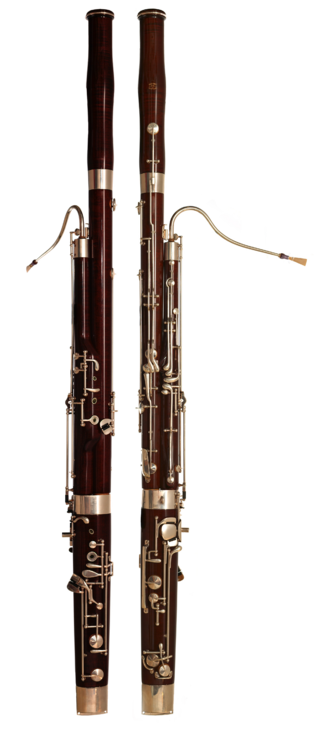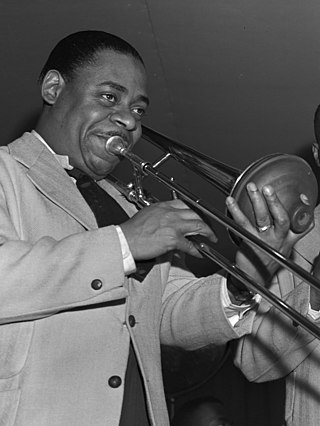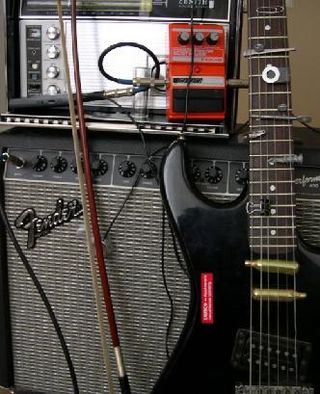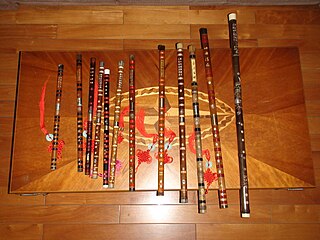
The bassoon is a musical instrument in the woodwind family, which plays in the tenor and bass ranges. It is composed of six pieces, and is usually made of wood. It is known for its distinctive tone color, wide range, versatility, and virtuosity. It is a non-transposing instrument and typically its music is written in the bass and tenor clefs, and sometimes in the treble. There are two forms of modern bassoon: the Buffet and Heckel systems. It is typically played while sitting using a seat strap, but can be played while standing if the player has a harness to hold the instrument. Sound is produced by rolling both lips over the reed and blowing direct air pressure to cause the reed to vibrate. Its fingering system can be quite complex when compared to those of other instruments. Appearing in its modern form in the 19th century, the bassoon figures prominently in orchestral, concert band, and chamber music literature, and is occasionally heard in pop, rock, and jazz settings as well. One who plays a bassoon is called a bassoonist.

The trombone is a musical instrument in the brass family. As with all brass instruments, sound is produced when the player's vibrating lips cause the air column inside the instrument to vibrate. Nearly all trombones use a telescoping slide mechanism to alter the pitch instead of the valves used by other brass instruments. The valve trombone is an exception, using three valves similar to those on a trumpet, and the superbone has valves and a slide.

The trumpet is a brass instrument commonly used in classical and jazz ensembles. The trumpet group ranges from the piccolo trumpet—with the highest register in the brass family—to the bass trumpet, pitched one octave below the standard B♭ or C trumpet.
Vibrato is a musical effect consisting of a regular, pulsating change of pitch. It is used to add expression to vocal and instrumental music. Vibrato is typically characterized in terms of two factors: the amount of pitch variation and the speed with which the pitch is varied.
The trill is a musical ornament consisting of a rapid alternation between two adjacent notes, usually a semitone or tone apart, which can be identified with the context of the trill. It is sometimes referred to by the German Triller, the Italian trillo, the French trille or the Spanish trino. A cadential trill is a trill associated with each cadence. A trill provides rhythmic interest, melodic interest, and—through dissonance—harmonic interest. Sometimes it is expected that the trill will end with a turn, or some other variation. Such variations are often marked with a few appoggiaturas following the note bearing the trill indication.

Joe "Tricky Sam" Nanton was an American trombonist with the Duke Ellington Orchestra. A pioneer of the plunger mute, Nanton is notable for his use of the distinctive wah-wah effect.

In music, extended technique is unconventional, unorthodox, or non-traditional methods of singing or of playing musical instruments employed to obtain unusual sounds or timbres.

The voiceless uvular fricative is a type of consonantal sound that is used in some spoken languages. The symbol in the International Phonetic Alphabet that represents this sound is ⟨χ⟩, the Greek chi. The sound is represented by ⟨x̣⟩ in Americanist phonetic notation. It is sometimes transcribed with ⟨x⟩ in broad transcription.
In phonetics, a trill is a consonantal sound produced by vibrations between the active articulator and passive articulator. Standard Spanish ⟨rr⟩ as in perro, for example, is an alveolar trill.

The dizi, is a Chinese transverse flute. It is also sometimes known as the di or héngdi, and has varieties including Qudi, Bangdi, and Xindi. It is a major Chinese musical instrument that is widely used in many genres of Chinese folk music, Chinese opera, as well as the modern Chinese orchestra. The dizi is also a popular instrument among the Chinese people as it is simple to make and easy to carry.
A multiphonic is an extended technique on a monophonic musical instrument in which several notes are produced at once. This includes wind, reed, and brass instruments, as well as the human voice. Multiphonic-like sounds on string instruments, both bowed and hammered, have also been called multiphonics, for lack of better terminology and scarcity of research.

Noye's Fludde is a one-act opera by the British composer Benjamin Britten, intended primarily for amateur performers, particularly children. First performed on 18 June 1958 at that year's Aldeburgh Festival, it is based on the 15th-century Chester "mystery" or "miracle" play which recounts the Old Testament story of Noah's Ark. Britten specified that the opera should be staged in churches or large halls, not in a theatre.

Leopold Stokowski's orchestration of Pictures at an Exhibition by Modest Mussorgsky was completed in 1939 and premiered later that year, on 17 November, by the Philadelphia Orchestra.
Motorbike Odyssey is the Trombone Concerto No. 1 by Swedish composer Jan Sandström. The concerto for solo tenor trombone and large orchestra, written in 1989, is sometimes called Motorbike Concerto. It was dedicated to the trombone virtuoso Christian Lindberg. The piece is meant to be a musical telling of a modern Odysseus, traveling the world with his trombone.

Sequenza X is a composition for trumpet and piano by Luciano Berio, the tenth in his series of pieces with this title. The work was commissioned by the Los Angeles Philharmonic for Thomas Stevens, and premiered by him on November 19, 1984. The piece is dedicated to Ernest Fleischmann, managing director of the Los Angeles Philharmonic from 1969 to 1997, who convinced Berio to write a Sequenza for trumpet, despite years of resistance to the idea. Stevens received the music only nine days before the premiere.
An offstage instrument or choir part in classical music is a sound effect used in orchestral and opera which is created by having one or more instrumentalists from a symphony orchestra or opera orchestra play a note, melody, or rhythm from behind the stage, or having a choir of singers sing a melody from behind the stage.

Saxophone technique refers to the physical means of playing the saxophone. It includes how to hold the instrument, how the embouchure is formed and the airstream produced, tone production, hands and fingering positions, and a number of other aspects. Instrumental technique and corresponding pedagogy is a topic of much interest to musicians and teachers and therefore has been subjected to personal opinions and differences in approach. Over the course of the saxophone's performance history, notable saxophonists have contributed much to the literature on saxophone technique.
The voiceless uvular trill is a type of consonantal sound, used in some dialects of some spoken languages. It is less common than its voiced counterpart.
The trombone is a musical instrument from the brass instrument family. Trombone's first premiere in jazz was with Dixieland jazz as a supporting role within the Dixie Group. This role later grew into the spotlight as players such as J.J. Johnson and Jack Teagarden began to experiment more with the instrument, finding that it can fill in roles along with the saxophone and trumpet in bebop. The trombone has since grown to be featured in standard big band group setups with 3 to 5 trombones depending on the arrangement. A person who plays the trombone is called a trombone player or a trombonist.

A velopharyngeal fricative, also known as a posterior nasal fricative, is a sound produced by some children with speech disorders, including some with a cleft palate, as a substitute for sibilants, which cannot be produced with a cleft palate. It results from "the approximation but inadequate closure of the upper border of the velum and the posterior pharyngeal wall." To produce a velopharyngeal fricative, the soft palate approaches the pharyngeal wall and narrows the velopharyngeal port, such that the restricted port creates fricative turbulence in air forced through it into the nasal cavity. The articulation may be aided by a posterior positioning of the tongue and may involve velar flutter.













